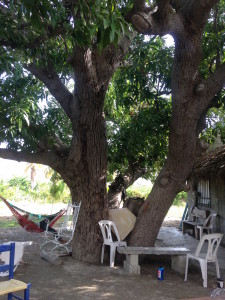I’m not really sure if I ever actually said the phrase, but at one point in the week I noticed that a few of the students would tease me by saying in a high voice “Me llamo Michele, me gusta the fish” (My name is Michele, I like the fish). Because everyone did it in a completely good natured, lighthearted way, this phrase cracked me up every time. There is no better way to describe myself! So thank you to Pete, Logan, and all the others who made this a “thing”!
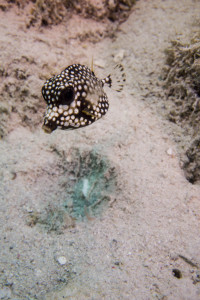
On to the second week with IU, we headed as a group back up towards the capitol on May 20th, to do work on the Begoña, located at a beach known as La Coleta (the cove). This is a public beach (and the only sandy beach for miles around, so it’s quite popular) so today was a great day to not only get work done, but also to interact and engage with the people visiting the beach just for a swim. We pulled up into the parking lot and immediately started unloading our bus with all the equipment for the day. We had tarps, tanks, dive gear, tents, line, buoys, metal detectors, tools, cameras, chairs, an inflatable boat and motor, to name a few things. Once we had generally set up camp, Dr. Beeker got to work briefing us on the tasks to accomplish for the day. Some students were going to be dredging a cannon out of the sand (due to wave action, the cannon is continually buried in the sand each year, so each year the students clear it out of the sand to be on display to the public). Another group was doing a biological survey, another group was using metal detectors to sweep the area for other possible significant archaeological artifacts from the shipwreck hundreds of years before, and another group (Seal Team 6) was installing a historic marker buoy to indicate the importance of the site.

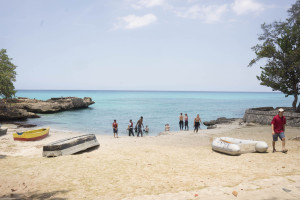
The day was a busy one for sure, and I shadowed Kirsten and Cassie, two students with a heavy interest and engagement in the archaeological side of the projects. Their task for the day was to use a device referred to as an “air lift” which is comparable to a mini dredge to clear the sand from the top and sides of the cannon, which was marked by some yellow line. They spent the whole morning sucking away sand, but the tasked almost seemed impossible, with large amounts of sand almost immediately filling in the space were sand had just been sucked away. Bryce and Pete sat in the inflatable above the cannon, operating the air tanks and dredge topside (and also acting as cabana boys). But everyone stuck with the task for a while and managed to get the end of the cannon exposed. The girls decided that the airlift just didn’t have enough power to clear the sand fast enough and more juice was needed to really get the cannon fully out and visible. After draining the last of the scuba cylinders on the inflatable, we swam back in to shore to offload and regroup with Dr. Beeker. By this point, it was early afternoon and most of the students had gathered topside to give updates and reports with their surveys. At this point, some locals who Matt had connections with had laid out a gorgeous lunch of local dishes and with most of us hungry and a bit cranky, we decided it was best to eat before doing more work. We had white rice, beans, barbecued chicken, moro (a black bean and rice dish that I fell in love with!), beef with vegetables, and fish with vegetables. One of my favorite things about going to new places is trying local foods and this lunch was a perfect and tasty display of what a Dominican might eat for a meal.
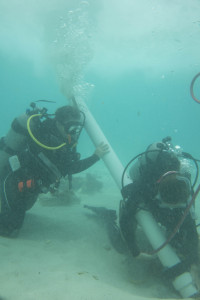
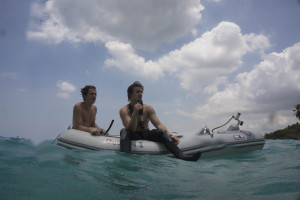
With our bellies full and morale high, Dr. Beeker went over what had been done thus far and what still needed to get done. A lot had been accomplished, which was great and allowed me the chance to try an Ocean Technology Systems (OTS) full face communications mask with Mylana (IU’s new DSO) and two students, Cassie and Robbie (one of the OWUSS 2015 interns). We spent a little bit of time going over the masks and parts before changing the hoses on our regulators and kitting up to get in the water. Robbie and Cassie were getting their specialty certification in the full face comm masks so had some skills to perform underwater. Mylana offered the same to me and I told her we’d see how I felt underwater with the mask, but I knew I’d at least try a few of the skills.
We quickly geared up and waded in the water, then submerged down to about 10 feet. Drawing my first breath of air was so strange! Very unlike breathing through a normal regulator as you can use your nose. But after a few breaths and looking around, I found it really easy and comfortable to use. It was also really neat to have the communications systems and radio call the others. Its great to actually be able to express what you want to say to your buddy instead of trying to talk over made-up hand signals. We swam out a bit deeper where Cassie and Robbie could do their skills (partial mask flood and mask removal and replacement). I gave the partial mask flood a try, which was actually quite similar to a normal mask clear. After everyone completed the skills, we went for a little swim around to get more comfortable in the masks. After 10 minutes, I could barely tell I was wearing a different mask. We stopped by where the other students were working diligently and making excellent progress to clear the cannon (it was now completely exposed from the sand) and slowly headed back in to shore to finish our dive. I am extremely grateful to Mylana and IU for bringing out an OTS mask for me to try and teaching me how to use one, along with OTS for creating such a useful product and sponsoring me throughout my year as the Rolex Scholar. I can definitely understand the draw to wearing a full face mask and am stoked to have had the opportunity to give it a try!
Once up from our dive, we got right back to work starting to take down and pack up all our gear, as most everything had been accomplished for the day. In addition to all the work completed at the site, there was a lot of interacting with the public throughout the day, and lots of genuine interest in the work being done. It was encouraging to see Dominicans interested in the history of their country and more importantly, in the preservation of their history. Like a well-oiled machine at this point in the week, the students had efficiently cleaned and packed up gear as it was brought back and loaded the bus in what felt like a blink of the eye. Once everyone was back and camp was cleaned up, we hoisted the newly minted plaque from the back of our rental truck onto the pavement, to commemorate the shipwreck almost 290 years ago. After a bit of a photo shoot to get some group images (started by my request), we finally loaded up the bus to head back to Bayahibe.
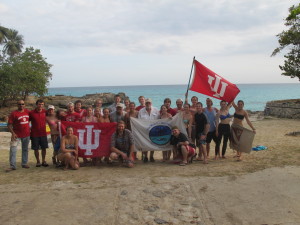
This was the students’ last night in the Dominican Republic and so they had journals to complete and reports to finalize, so the bus ride offered a great time for everyone to get some work done. Back at the resort, we had a big group dinner (once everyone was showered and cleaned up) and then a meeting up in the power tower (where the students had spent time during the trip meeting and collaborating amongst themselves). An overall debriefing of the 10 days was given by Dr. Beeker, then some little awards given out to students, then nice words shared all around. After all the formalities for the night, shenanigans were to be had by most of the group. Everyone wanted to take advantage of the last night all together, and it was a perfect way to end the trip.
The next morning came a little too quickly for most and after eating a quick breakfast, the students loaded on the bus for their trip to the airport. After warm goodbyes, the students headed out and the rest of us, Dr. Beeker, Billy, Matt, Mylana, Sam and I, quietly sat and reflected on the 10 days and all the students had accomplished. We used the rest of the morning to pack our own personal luggage and checked out of the resort and headed back to Santo Domingo for the afternoon. We were to spend the next 3 days in a beautiful, old, Spanish-style hotel in the city. The original plan had been to use the extra days and the help of the Navy’s boat to lift and drop some cannons at a site, but unfortunately these plans fell through when we found out the boat was put in dry dock.
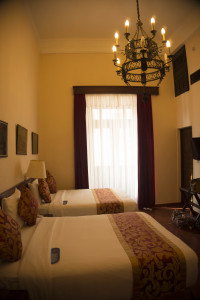
We instead spent most of May 22nd further cleaning and organizing the IU lab as well as more thoroughly cleaning, disassembling and packing gear to be taken back to the states. We spent the morning working hard and getting a lot done, plus Dr. Beeker had some political networking to do for the morning. After finishing up at the lab, we headed to a quiet little corner café for lunch, where I had some delicious empanadas and chilena (fresh made passionfruit juice), we headed to the shore to scout for the Memphis, a US Navy battle cruiser that was wrecked in 1916 that Dr. Beeker had some interesting in taking a closer look at. We pulled up to the shore where men were fishing with hand lines and a few spearfishermen were chatting on the shore. Dr. Beeker and Matt walked up to those men and started asking them if they knew about a shipwreck in the area and they quickly called for one of their friends, who was still in the water, to come up and talk. The man was a local in the area who had fished there for 27 years and knew a surprisingly large amount about the wreck, and had actually pulled artifacts from it. He went home to grab a few pieces and came back to continue talking with us and show us the metal bits he had gathered. It was incredible what a wealth of knowledge the fisherman had and to see Dr. Beeker utilizing the knowledge of locals to gain information was great. After quite a lot of detail was gathered from the local, we motored back to our hotel where we cleaned up and had an enjoyable dinner at an eclectic restaurant called “El Meson.”
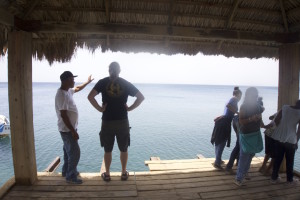
Saturday, our last full day in the Dominican Republic, was actually one of my favorite days of the entire trip. Because our original plans had fallen through, we semi-invited ourselves to Francis’ farm. Francis is the unofficial head of the Submerged Resources department for the past 27 years and has had a longstanding friendship with Dr. Beeker and Billy, continually giving IU his support and helping with the political moves that need to be made to make each trip possible. Francis owns a farm in the southwest of the country, in the more arid mountains right near the coast. We woke up bright and early to drive over, and spent the day like a true Dominican. We ate multiple delicious, home-cooked Dominican meals, explored the vast plantain farm, rested in hammocks underneath a gorgeous old mango tree, and chatted and talked business. We also went on an informal tour of the nearby town with the oldest sugar mill in the country and Mylana and I explored the back fields in search of the supposed iguanas that were in the area (as told to us by Matt). We ate more food and coffee and then a group of us explored the nearby floodplain in search of a possible archaeological site, which turned out to be a bust but still a fun expedition. When we got back to the farm house, a huge meal awaited us, which we promptly chowed down on and then rested off in the shade. All in all, it was a perfect way to end the trip.
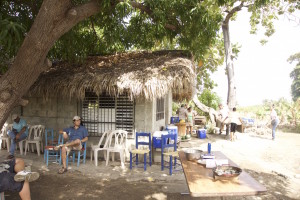
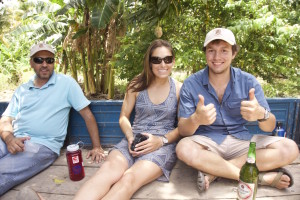
I couldn’t be more grateful to Dr. Beeker, Mylana, and the rest of the group at Indiana University for allowing me to join in on this trip. It was an incredibly experience where I learned about the rich history of the Dominican Republic as well as the work it takes to create these “Living Museums of the Sea” and get support from the local community. While I had no idea what I was getting myself into when I agreed to join this trip, it has been a perfect experience for me in learning a new way the dive tourism industry can use history as a means to promote a sustainable economy as well as educate and enrich an array of people.
